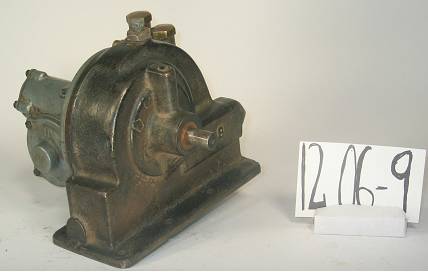Pressure Atomizing Oil Burner Equipment and Systems – Oil Pumps
A fuel pump assembly for low pressure, mechanical atomizing oil burner, with direct, flexible coupled, electric motor drive, with carbon blade rotary pump, worm drive, gear pump, and automatic oil volume and pressure control valves, from the widely acknowledged pioneer of automatic oil heating equipment in Canada, Fess, Model D8, Circa 1924.
Technical Significance:
They were the early years of the 20th century and “the machine” had arrived in the basements of a few well to do Canadian homes – whether the refrigerating machine [see condensing unit Group 2.01] or the automatic oil burning, home heating machine.
The Fess Model D would typify the latter. Like many such arrivals it would first appear, celebrated for its potential contribution to human comfort, health and convenience, only much later as a social and cultural change agent with awesome impact on Canada and Canadians, their life and times.
The Model D [There was a series of them] represented the leading edge of self- powered, self-regulating, automatic oil heating technology of the period, likely the first wave of pressure atomizing technology commercially marketed in Canada. The mechanism was described by Fess as being of the low pressure, mechanical atomizing type, using “the retarded heat principle”. It consisted of what the Fess manual refers to as a “machine proper” and a “fire door insert”.
The machine proper included a heavy steel pedestal on which was mounted this assembly consisting of a carbon blade rotary pump, worm driven gear pump, with rotary needle valve, including oil volume and pressure adjustments.
The assembly was driven with a direct coupled repulsion induction motor [see Group 16.00], drawing oil from a float control, valve chamber with strainer. The entire machine proper rested in trays that caught leaking oil, with provisions for sucking it back into the system.
The fire door insert included nozzle assembly, ignition transformer and spark plug
The burner was controlled with a Model 77, Locksmith, stack switch [See Group 12.08]
Industrial Significance:
Appearing in the early 1920’s, Canadian household machinery was initially styled after its industrial counterpart in cast iron, steel, light weight die casting alloys, brass and bronze, using the industrial processes available in the times.
Fess Oil Burners of Canada [later the John Wood Company, Toronto] became a major player in the development of the automatic oil heating industry, starting in the 1920’s
The industry would shortly move on to a more compact, functionally integrated, unitary equipment look, thus distancing itself from the factory floor. See ID# 267 – but for now the D series was as good as it gets.


